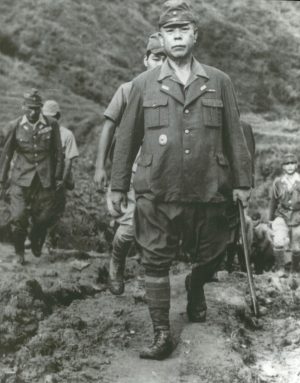While the Battle of Manila has received less historical attention than the battles that immediately preceded and followed (Leyte, Iwo Jima, and Okinawa), it has come to occupy an inordinate place in the Law of Armed Conflict. In particular, the American decision to try and then execute Gen. Tomoyuki Yamashita established a standard for war crimes prosecution that remains controversial to the present.
Much legal work in the immediate aftermath of the war was geared toward ensuring that the crimes of the Axis, and sometimes even the Allies, would be subject to legal sanction in the future. The course of the Pacific War provided much grist for this effort, with Japanese treatment of prisoners of war and interned civilians receiving significant attention. Consideration of American bombing of Japan cities and of the American refusal take prisoners in battle would come later. In the immediate aftermath of the Japanese surrender, the defense of Manila was the single most consequential event of the Pacific War from the point of view of the law of armed conflict. Japanese behavior at Bataan and Corregidor had been central to American news coverage of the war, and the massacre at Manila remained fresh in American (and Filipino) minds as the war ended.
The behavior of Yamashita came under close scrutiny. Yamashita had held out in northern Luzon until September 2, two weeks after the cessation of hostilities between the Allies and the Japanese Imperial government. When Yamashita did surrender, he was quickly arrested and detained for trial. U.S. prosecutors argued that Yamashita was responsible for the massacres committed by Japanese forces against civilians in Manila. The near complete annihilation of the Manila garrison was not regarded as sufficient to the demands of justice.
Yamashita’s defense rested on a straightforward argument: while the general did not declare Manila an open city (as MacArthur had done in 1942), he did give orders for the evacuation of Japanese military forces from its environs. Yamashita’s subordinates had thus disobeyed direct orders to evacuate Manila before the Americans closed the ring around the city. Although Yamashita did not directly order his forces to spare civilians, prompt obedience would have made it impossible for the troops to commit massacres.
The prosecution case rested on the idea that the very fact of Yamashita’s loss of control over his subordinates made him responsible for their behavior. As the supreme Japanese commander on Luzon, Yamashita was inherently responsible for maintaining his troops in good order, and ensuring that they did not violate the laws of armed conflict. Yamashita had failed in this responsibility by not taking sufficient steps to ensure the obedience of his subordinates, and was thus legally responsible even though he was on a different part of Luzon at the time. It did not help that Yamashita was also implicated in war crimes committed by Japanese soldiers in China during the Sino-Japanese War, and in the treatment of Allied POWs in the Singapore and Malaya campaigns.
The Americans wasted little time putting Yamashita on trial; he entered the docket in October 1945, and a verdict of death was rendered by early December. Yamashita’s attorneys appealed the verdict and requested clemency from the U.S. Supreme Court and from President Harry Truman, both of which were denied. Yamashita was hanged in the Philippines in February 1946, well before the opening of the Nuremberg Trials or the Tokyo War Crimes Tribunal. While the execution remains debatable in the sense that there are good arguments on either side, there is little question that it represented “victor’s justice” in the sense that it touched upon specific American and Filipino sensitivities regarding the occupation of the Philippines.
The concept of “command responsibility” has been codified to greater or lesser extent in various Law of Armed Combat texts since the late 1940s, and has been applied to a wide variety of situations. The idea that commanders can be held legally accountable for the activities of their troops, notwithstanding the lack of any direct orders, has come to be known as the Yamashita Standard. The Nuremberg, Yugoslavia, and Rwanda tribunals have all invoked the idea of command responsibility, while some commentators have argued that it could easily be applied to U.S. political and military leadership during the global War on Terror. It remains one of the most enduring legacies of the Pacific War, and of the liberation of the Philippines.

































